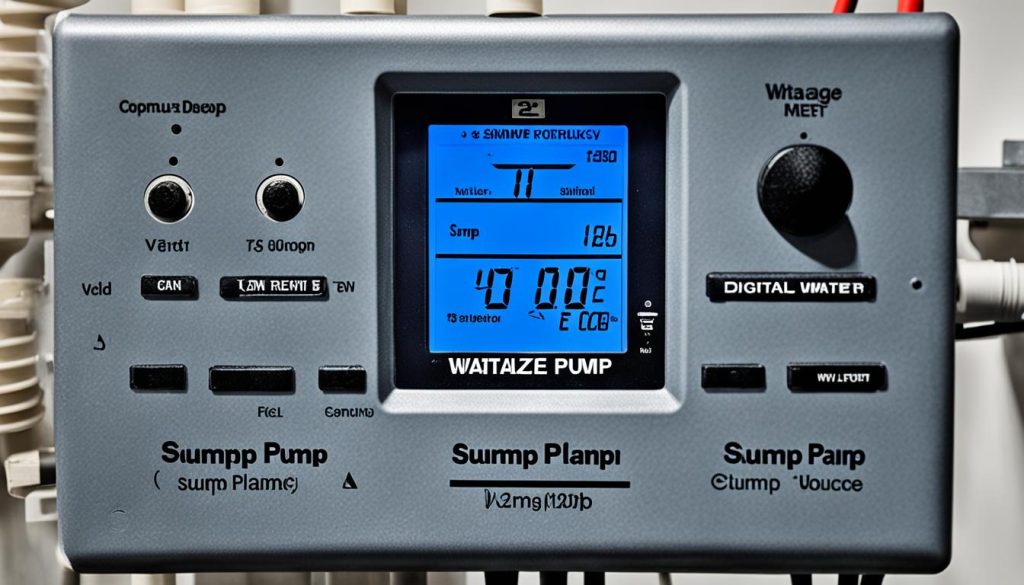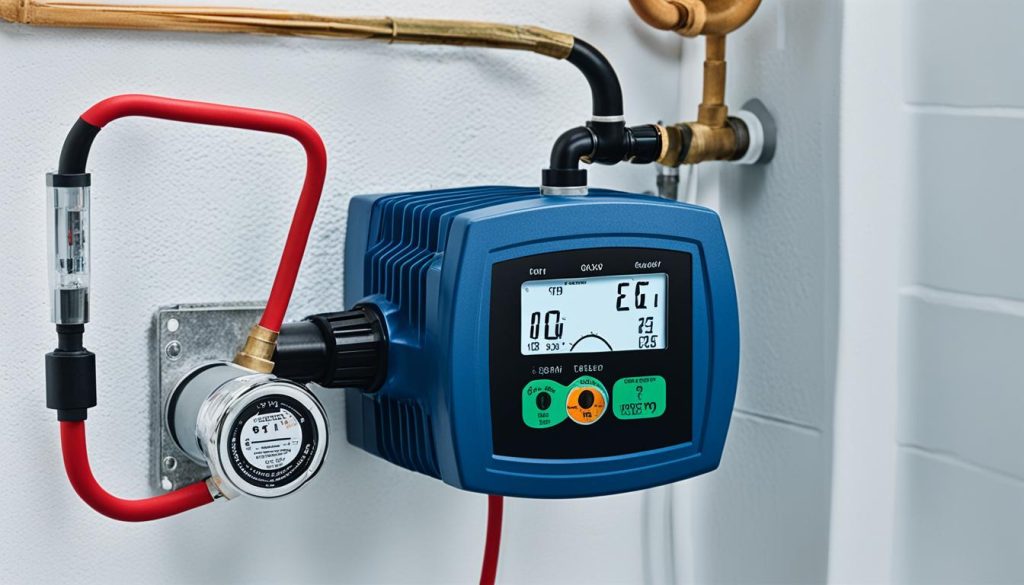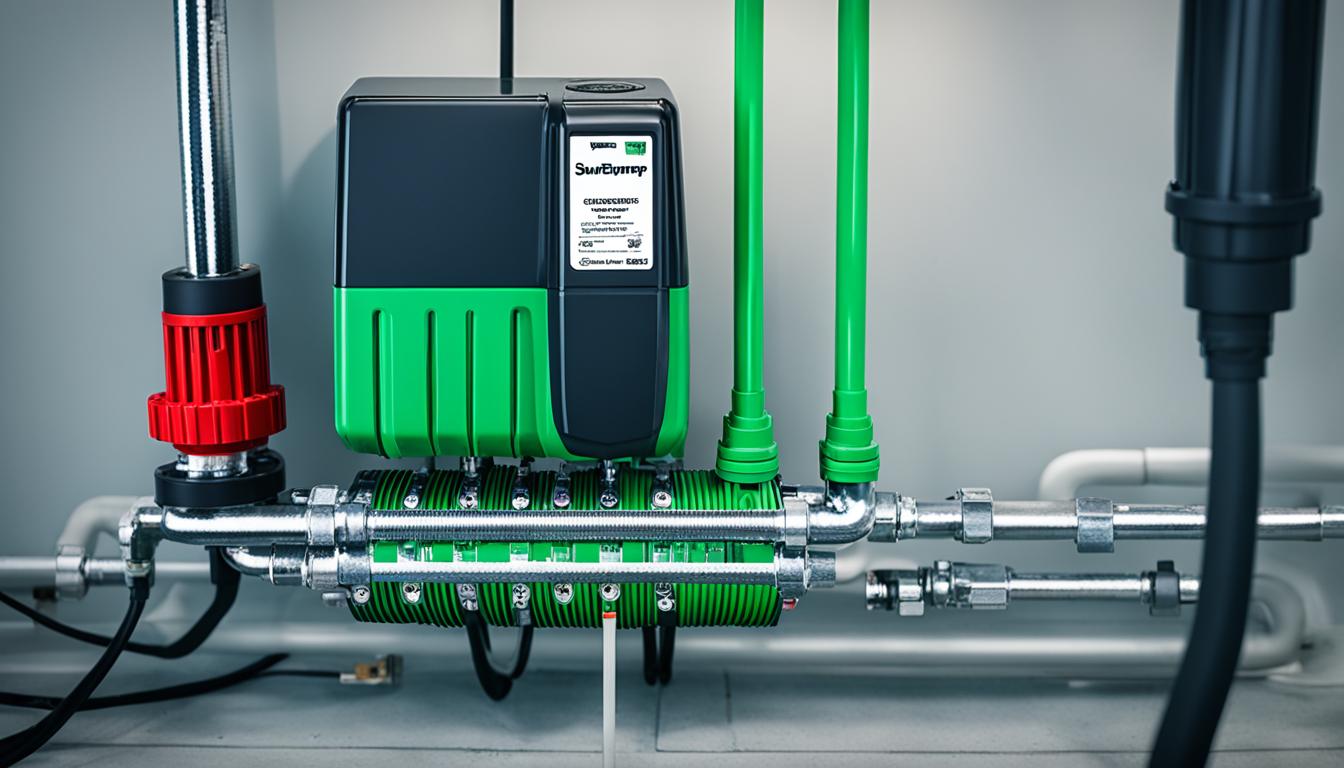Did you know that choosing the right wattage for your sump pump could mean the difference between a dry basement and costly flooding? Understanding sump pump power consumption is crucial for maintaining optimal power efficiency and ensuring your sump pump operates effectively. Let’s dive into the world of sump pump wattage and discover how to make the right choice.
Key Takeaways:
- Choosing the right wattage for your sump pump is essential to prevent flooding and save energy.
- There are float activated and pressure activated sump pumps, each with their own advantages.
- To calculate sump pump wattage, consider the voltage, amperage, motor efficiency, and duration of operation.
- Backup power options such as portable power stations and deep cycle marine batteries provide peace of mind during power outages.
- Regular maintenance and monitoring are key to ensuring efficient sump pump operation and extending its lifespan.
How Sump Pumps Work and Choosing the Right Pump
When it comes to protecting your basement from flooding and keeping below-grade rooms dry, sump pumps are an essential tool. Understanding how sump pumps work and choosing the right pump for your needs is crucial. Let’s explore the working mechanisms of sump pumps and the importance of selecting the proper power rating.
There are two main types of sump pumps: float activated and pressure activated. Float activated pumps are equipped with a float switch that automatically starts the pump when the water level rises. On the other hand, pressure activated pumps rely on water pressure to trigger their operation. The water level doesn’t directly control pressure activated pumps.
Choosing the right sump pump for your situation depends on the amount of flooding you typically experience. If your area is prone to heavy rainfall or frequent floods, a more powerful pump may be necessary. However, it’s important to consider the energy efficiency of the pump as well, as more powerful pumps tend to consume more electricity.
Properly assessing the power rating of a sump pump is essential to ensure efficient and reliable operation. A sump pump with the correct power rating can handle the necessary water flow and prevent basement flooding effectively. It’s crucial to identify the specific power requirements based on your basement’s size and the potential water volume you need to handle.
Float Activated Sump Pumps
Float activated sump pumps are widely used and rely on a float switch to detect rising water levels. When the float switch rises with increased water level, it triggers the pump’s operation and directs the water away from your basement.
Pressure Activated Sump Pumps
Pressure activated sump pumps, also known as water pressure sump pumps, rely on water pressure to initiate their operation. As water enters the sump pit, it increases the pressure inside the pump, triggering the pump to start and expel the water outside.
It’s essential to remember that along with power rating, other factors like durability, reliability, and brand reputation should also influence your decision when selecting a sump pump.
Choosing the right sump pump and understanding how it works are crucial steps in safeguarding your basement from potential flooding. In the next section, we’ll explore how to calculate sump pump wattage and power consumption to ensure optimal operation and efficiency.
n
Calculating Sump Pump Wattage and Power Consumption
Calculating the wattage and power consumption of your sump pump is crucial for determining its electrical usage and ensuring optimal operation. By considering the sump pump’s voltage and amperage requirements, you can accurately estimate its power needs. Let’s explore the steps to calculate sump pump wattage and power consumption.
Step 1: Identify Voltage and Amperage Requirements
To begin, consult your sump pump’s specifications or user manual to find the voltage and amperage requirements. These values are essential for accurate wattage calculations. For example, let’s say your sump pump requires 120 volts and 10 amps.
Step 2: Calculate Power Consumption using the Formula
The formula to calculate power consumption (in watts) is:
Power (Watts) = Voltage (Volts) × Current (Amperes)
Applying this formula to our example, the power consumption of the sump pump can be calculated as:
Power (Watts) = 120V × 10A = 1200 Watts
Step 3: Consider Starting Power and Optimal Wattage
It’s important to account for the starting power of the sump pump, which can be three times the running power. This extra power is necessary to handle the initial load when the pump starts. Including the starting power in your calculations ensures that the sump pump operates smoothly without overloading.
When determining the optimal wattage for your sump pump, consider the motor efficiency and the duration of the pump’s operation. Higher wattage pumps may be necessary if you often face severe flooding situations or if your pump needs to operate for extended periods.

Sump Pump Wattage Calculator:
| Sump Pump Specifications | Value |
|---|---|
| Voltage (Volts) | 120 |
| Amperage (Amperes) | 10 |
| Power Consumption (Watts) | 1200 |
| Starting Power (Watts) | 3600 |
Using this sump pump wattage calculator, you can easily determine the power consumption and starting power of your sump pump based on its voltage and amperage requirements.
By accurately calculating sump pump wattage and power consumption, you can make informed decisions about selecting the optimal wattage for your specific needs. This enables you to maintain an efficient and reliable sump pump operation, contributing to a dry and protected basement.
Backup Power Options for Sump Pumps
Having backup power for your sump pump is crucial in case of power outages or storms. When the main power source fails, a backup power option will ensure that your sump pump continues to operate, preventing potential flooding in your basement. There are two popular backup power options for sump pumps:
1. Portable Power Stations
Portable power stations are versatile and convenient backup power solutions. They are compact, rechargeable battery-powered units that can be easily transported and connected to your sump pump. These power stations come in various capacities, so it’s important to choose one that meets the energy-efficient sump pump wattage requirements.
2. Deep Cycle Marine Batteries
Deep cycle marine batteries are another reliable option for backup power. These batteries are designed to provide a consistent and sustained power supply, making them ideal for sump pumps. To use a deep cycle marine battery as a backup power source, you will need an inverter to convert the battery’s DC power to AC power that the sump pump can use.
When choosing a backup power source for your sump pump, consider the following:
- The wattage requirements of your sump pump
- The capacity and runtime of the power station or battery
- The availability of charging options for portable power stations
- The compatibility of the battery and inverter for deep cycle marine batteries
It’s important to select energy-efficient options and top-rated products to ensure the reliability and effectiveness of your backup power solution. Now, let’s take a look at a comparison table that highlights the key features of portable power stations and deep cycle marine batteries for sump pump backup power:
| Features | Portable Power Stations | Deep Cycle Marine Batteries |
|---|---|---|
| Portability | Easily transportable | Requires additional setup |
| Capacity | Varying capacities available | Depends on battery size |
| Runtime | Varies based on capacity and usage | Depends on battery size and charge |
| Charging Options | Various charging methods available | Requires a charger or inverter |
| Compatibility | Compatible with most sump pump models | Requires inverter for AC power |
| Price Range | $$ – $$$ | $$ – $$$ |

As you can see from the table, both portable power stations and deep cycle marine batteries have their own advantages and considerations. Evaluate your specific needs, the wattage requirements of your sump pump, and the available options to make an informed decision that best suits your backup power needs.
Tips for Efficient Sump Pump Operation and Maintenance
To ensure the efficient operation of your sump pump, proper maintenance is essential. One crucial factor in maintaining the efficiency of your sump pump is selecting the proper power rating. The right power rating ensures that your pump operates optimally, preventing flooding and saving energy.
Regularly checking the drainage system is vital to prevent water seepage back into the basement. Inspecting and cleaning the sump pump and its basin on a regular basis is also necessary. In addition, lubricating the pump’s bearings when needed helps to maintain smooth and efficient operation.
Monitoring your sump pump’s performance is crucial in detecting any issues or failures. Utilize a monitoring system or app to keep track of the pump’s operation. If you notice that the pump is running continuously or making unusual noises, it may be time for a replacement. Following these maintenance tips will not only extend the lifespan of your sump pump but also ensure its power efficiency.
